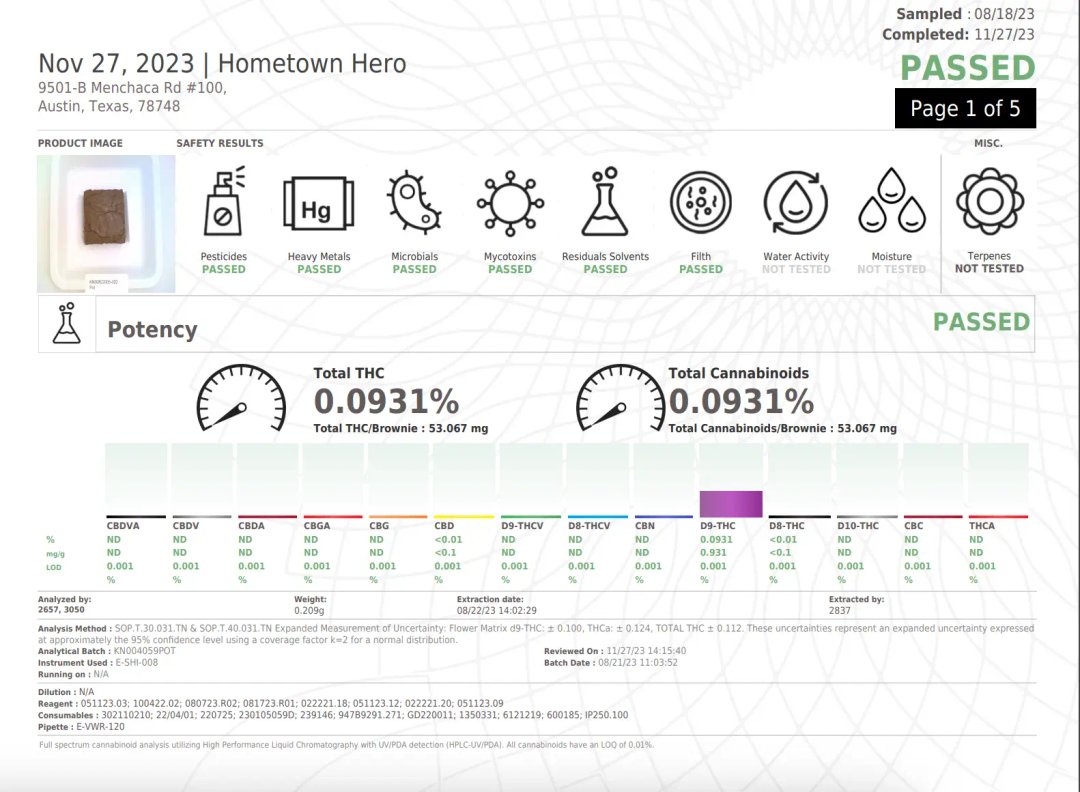So you have a Delta-8 COA in front of you. Perhaps it's the COA for Hometown Hero's Blueberry Delta-8 gummies. Here's how you want to go about interpreting it.
COA for Hometown Hero's Blueberry Gummies (in case you wanted to follow along)
Header
First, you want to check the lab. In the document linked above, for example, ACS Laboratory developed the COA for Hometown Hero's Blueberry Gummies.
Some things you'll want to ask are "Does the laboratory have a website? Do they have their address listed on the COA?"
You can find ACS's website at acslabcannabis.com. On the COA, their address can also be found.
Results Summary
Some COAs have a results summary toward the top. This is done out of convenience for the consumer and manufacturer. Right off the bat, you can tell where and if a Delta-8 THC product has passed the laboratory's tests.
At the top of the COA for Hometown Hero's gummies, you can find results for:
- Potency
- Heavy Metals
- Mycotoxins
- Pesticides
- Residual Solvents
- Pathogenic Microbiology
- Listeria Monocytogenes
Detailed Results
The rest of the COA will give specific breakdowns of the results.
There are four primary columns in the detailed results for the Hometown Hero COAs done by ACS Laboratory.
From left to right, they read as "Analyte," "LOQ," "Action Level," and "Result." Here's what each of those columns means:
- Analyte - The substance the test was measuring
- LOQ - Stands for "limit of quantitation," the lowest amount in which a lab can reliably detect a substance
- Action Level - The maximum safe amount of a substance
- Result - How much of the analyte was detected
From left to right, you can read what’s being measured, the lowest amount of that substance that can be detected, the safe limit of that substance, and then, the results.
Footer
A good footer in a COA adds legitimacy to the results. A lab might put the name and title of the toxicologist who carried out the test. The signature of the principal scientist may follow this.
A reliable laboratory will also have its licenses and certifications at the bottom. It's third-party verification for the test. One of the most significant certifications is a DEA registration.
COA Red Flags
Right off the bat, a Delta-8 product without a COA is a bad sign. However, having a COA may not be good enough if the COA is illegitimate. So what are the warning signs?
One of the biggest red flags when it comes to COAs is inconsistent formatting. A COA with inconsistent formatting could have been forged.
Some of the formatting inconsistencies can include:
- Spacing
- Punctuation
- Terminology
- Headers and footers
Laboratories that test Delta-8 products might have a sample of their COA format for reference. ACS Laboratory, the company that tests Hometown Hero products, has a sample COA on
its website.
Another red flag is when a COA is missing sections. For example, a Delta-8 product's COA may contain its cannabinoid content. However, it might lack tests for different types of contaminants.
Finally, one of the most significant red flags you can find in a COA is a "ghost address." A reliable third-party lab will have its address listed on the COA.
It's a bad sign if you Google the address and either nothing comes up or it's a residence. ACS Laboratory's location can be found on
Google Maps.
Hometown Hero COAs
At Hometown Hero, quality and safety are our top priorities when it comes to our products. It’s why we only use hemp-derived cannabinoids. It’s why we spend everywhere from weeks to months developing and testing new products. You can find all of our COAs on our website (on every product page).
We would be more than happy to be your preferred source for all your favorite cannabis products. However, no matter who you buy from, we hope you make a safe and informed decision.
Until next time, happy exploring, and Mind Your Mind.


